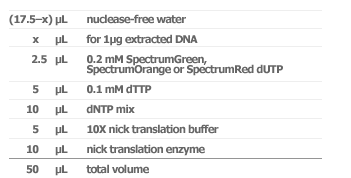This procedure labels approximately 1 µg of extracted P1, BAC, or YAC DNA. This is enough for ten FISH experiments (one target area equal to 22 mm x 22 mm).
- Place a microcentrifuge tube on ice and allow the tube to cool.
- Add these components to the tube in the order listed. Briefly centrifuge and vortex the tube before adding the enzyme (last component):

- Briefly centrifuge and vortex the tube.
- Incubate 8 - 16 hours at 15 °C.
- Stop the reaction by heating in a 70 °C water bath for 10 minutes.
- Chill on ice.
Determining the Probe Size
Determining the probe size is an essential part of the labeling procedure. For detailed instruction on preparing and running an agarose gel see (1) Maniatis T, Fritsch EF, and Sambrook J. Gel electrophoresis of DNA. In: Molecular cloning: a laboratory manual. 2nd ed. Cold Spring, NY: ColdSpring Harbor Laboratory; 1989 or (2) Ausubel FM, ed. Preparation and Analysis of DNA. In: Current Protocols in Molecular Biology. New York: Greene Publishing Associates and John Wiley & Sons, 1989.
NOTE: Because of the isomeric structures of the fluorophores, the unincorporated dUTP appears on the agarose gel as two domains of differing brightness. The chemical structure and net charge of the different fluorophores affect the migration pattern on the gel. For example, unincorporated SpectrumGreenTM dUTP migrates to the top of the gel, while SpectrumOrangeTM and SpectrumRedTMdUTP migrate further down the gel and may overlap the probe DNA smear.In this case,you need to remove the unincorporated dUTP by ethanol precipitation and/or gel filtration of the labeled probe DNA before loading a sample of the probe DNA on the agarose gel for sizing.
As you increase the amount of enzyme and the incubation time, the size distribution shifts to progressively smaller probe fragments. To produce smaller probe fragments use the following conditions that are listed in order of decreasing fragment size:
5 µL enzyme mix/8 hour incubation, 5 µL enzyme mix/16 hour incubation, 10 µL enzyme mix/8 hour incubation and 10 µL enzyme mix/16 hour incubation. Adjust the amount of nuclease-free water added to keep the total reaction volumeat 50 µL.


.jpg)
